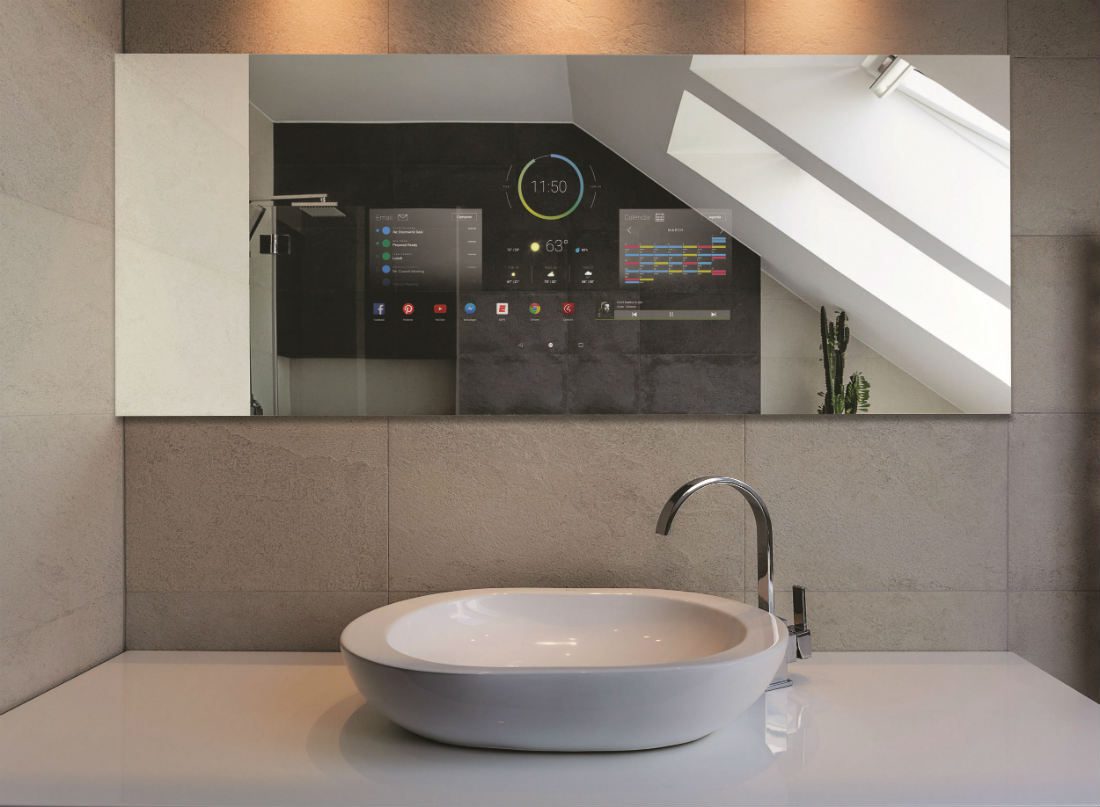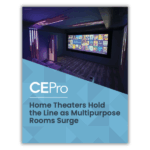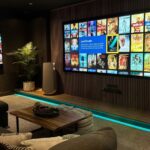CEDIA Expo 2018 may be long gone, but the big smart-home show will feed us great home-tech stories for many months (or years) to come.
CE Pro and every other outlet (and most dealer attendees) covered much of the big headline-grabbing, bread-and-butter news at the 2018 event – 8K displays, MicroLED panels, stunning loudspeakers, motorized everything, smart speakers and voice assistants, and … and Google and Nest.
But those who wandered the rest of the show probably found some fresh new opportunities in booths as small as 10 x 10. The products didn't necessarily dazzle, but they did make you go Hmmmmm.
Motorized patio umbrellas, water valve controllers, multifunctional sensors and smart mirrors were just a few of the product categories on the road to critical mass in the CE Pro community.
Delivering a new twist to home technology, these categories could help integrators expand into new markets and generate new streams of revenue.
After having some time to let these products marinate in our heads over the last few months, we've come up with a list of a few niche products that captured our attention …
Smart Mirrors
In the latest survey of home remodelers by the National Association of Home Builders, bathrooms claimed the top spot, followed by kitchens, as the most popular space to remodel (81 percent vs. 78 percent). This presents a huge opportunity to sell technology as part of the total redo.
Smart mirrors are ideally suited for bathroom renovations, and companies like Electric Mirror, Clearview Displays, Agath, Aquavision and Séura are packing cool new features into their bathroom vanity mirrors, building on their portfolio of TV mirrors. Both companies offer mirrors — of custom sizes and styles — into which a variety of apps can be downloaded.
Those can be apps from third-party control systems, individual smart home products, music streaming services, weather forecasts, etc. Both also offer mirrors with Bluetooth built in, so music can be streamed to and played by integrated speakers in the mirror.
The integration of control and music are huge selling features, as it mitigates the need for keypads, remotes, and standalone speakers — elements that take up space and can sometimes bother designers and remodelers. Séura, meanwhile, has added Amazon Alexa capabilities to a new line of mirrors.
The voice-enabled technology is built into the company’s SMART Mirror, as well as Bluetooth; a user speaks and the mirror responds. Séura’s Alexa/Bluetooth mirror received a positive reaction, as integrators clearly appreciated the wow factor, as did a contingent of interior designers who got to interact with the fingerprint smudge-free mirror on one of their Design Connection Tour stops.
The product is a great way to elegantly and intuitively bring tech and voice into the bathroom — especially since it’s one of the most utilized rooms within the home, just behind the kitchen! “Alexa, play my Wake Up playlist.” “What’s the weather forecast for today?” “Alexa, turn the temperature down to 65 degrees.”
Purpose-Built & Multipurpose Sensors
Sensors are the sentinels of the smart home. They watch for changes in the home environment, transmitting alerts and engaging automation scenes. Over the years, sensors have become smarter, more versatile, and more proactive. 2GIG and parent company Nortek Security & Control proved it this year by developing sensors for very specific applications.
Samsung took a different approach by developing for its SmartThings line a sensor that can be used for a multitude of different purposes.
Designed expressly for gun-owning households, the Gun Motion Detector from 2GIG attaches to the trigger of a handgun, rifle or shotgun, and sends an alert to a smartphone app if the gun is moved.
Operating in a similar manner but for different circumstances is the 2GIG Stove & Grill Guard. It attaches to most stove and grill knobs to alert homeowners if the oven has been left on. Like many of 2GIG’s sensors, a remote app can be used to set specific rules; for example, only send a notification if the stove has been left on for more than 30 minutes.
Both the Gun Motion Detector and the Stove and Grill Guard can send notifications to a 2GIG GC2 or GC3 touchpanel, as well as Honeywell systems.
Meanwhile, a couple of checklist items for sensors might be to monitor for fluctuations in temperature and to know when a door or window has been open. What makes the Multipurpose Sensor from Samsung SmartThings unique is it can monitor for both conditions, as well as vibration. Why vibration?
As the spokesperson at the SmartThings exhibit explained, it’s a great way to know when a washing machine or dryer is unstable. As for its application to doors and windows, SmartThings suggests thinking beyond the exterior of a home.
The Multipurpose Sensor is useful for doors on liquor cabinets, kitchen and bathroom cabinets to protect toddlers from cleaning supplies, and drawers that are off-limits.
Extremely Portable Door Cams
Think of your clients. Now think of your clients’ kids. They might be living in dorm rooms, apartments or sharing rent with friends. Drilling, cutting, and mounting products permanently in these types of dwellings is often prohibited, leaving few options for home security. This is precisely why Remo+ developed its RemoCam.
This wireless doorcam hangs over the door much like an over-the-door hook rack. Its adjustable bracket can fit the width of most doors, and can be secured in place with a few screws. Despite the easy installation process, the RemoCam boasts impressive monitoring capabilities.
Related: DIY Doorcams from Remo+ and Panasonic Present Opportunity for Pros
Thanks to its over-the-door design, the Wi-Fi chipset and antenna are housed in the back of the device, which is situated inside the home, rather than outside. This results in optimal connectivity and video transmission. It has a 160-degree field of view, sends push notifications to a user’s smartphone, and delivers 720p HD video.
A built-in microphone supports two-way video, and video footage can be recorded to view later.
Smart Enablers for Dumb Products
Many home-automation vendors make little smart-enabling relays that turn dumb analog products into smart devices. A simple relay wired to the legacy device can “push the buttons” remotely via Z-Wave, ZigBee, Bluetooth, and other standard smart-home standards, as well as proprietary protocols like Crestron's Infinet.
Recently, home-automation developer Fibaro, part of the Nice Group of companies, announced “Implant,” a tiny adapter that Z-Wave-enables relay-controllable electronics.
All that old gear your clients own can be added to the control platform. Think record players, VCRs, CD players, and other outdated gear that some customers simply can’t part with. Stay tuned for U.S. availability.
Smart Water Valve Controllers
Based on the number of smart water valve controllers showcased at CEDIA Expo 2018, intelligent plumbing could be the next big thing for the smart home. The good news is, you don’t need a plumbing license to install them.
These solutions have been widely available at consumer outlets like Amazon and Home Depot, but as is the case with other types of DIY products, many consumers would still rather have a pro handle the installation and setup. It’s the reason these manufacturers are now developing special programs for not only plumbers but also home systems professionals.
They are also proving their commitment to the pro channel by though integration with popular third-party products and control systems and, of course, simply exhibiting at tradeshows like the CEDIA Expo.
So why should you care about smart plumbing products? Sure, you’ll probably need to install a lot of them to make it worthwhile, but they’re an easy sell.
More than 14,000 water damage claims are filed with insurance providers each day the U.S., with the cost of restoration averaging $12,000. Even the tiniest of leaks in a water line can do serious damage. A 1/8- inch crack in a pipe can spill 250 gallons of water in a day.
Most of the water valve controllers displayed at the CEDIA Expo can be installed in less than 15 minutes, providing a great opportunity to get in and out of a job quickly, and providing your customers with unbeatable peace of mind.
Related: LeakSmart Brings New Market Opportunity with Smart Leak Detection to CEDIA Expo 2018
The way by which the Flo water valve controller detects leaks is unique and innovative. It continually monitors the water pressure; when that pressure changes, it could be a sign of trouble, like a small leak — even one as small as a drop of water per minute. Your customers would likely never know a leak like this existed until months later when they actually see the damage.
Another perk: Flo Technologies offers customers a reimbursement program called HomeProtect. For $5 a month, program will reimburse homeowners for their insurance deductibles, up to $2,500 if their Floequipped home suffers major water damage.
Customers can receive notification through the Flo app, view water consumption habits and adjust the valve’s level of vigilance, like having the valve automatically shut off the water line while homeowners are on vacation.
In other modes, it might send a notification but wait for a user to command the valve shut. Where LeakSmart really stands apart is in its degree of integration. It works with Nest, Control4, and soon Google Assistant and Amazon Alexa. Should a Nest thermostat detect a drop in temperature, for example, it can signal the LeakSmart to turn off the water line to prevent freezing pipes from bursting.
The valve controller can be controlled and automated as part of a Control4 ecosystem, as well. Upcoming Amazon Alexa and Google Home integration will enable control via voice commands.
The Guardian from Elexa is not just a smart water valve. It’s an entire suite of water mitigation products that work together via a Z-Wave bridge to protect a home. Also available are a leak sensor, door/window sensor, motion detector, and a smart electrical plug. Plus there’s a battery backup device that keeps the valve controller working in a power outage.
Robotic Patio Umbrellas
The creation of outdoor living spaces is one of the biggest trends in homeownership for 2018. People are spending big bucks to transform their backyards into legitimate living spaces, complete with fully functional kitchens, high-quality audio systems, weather-resistant displays and automated landscape lighting.
Offering integrators another element to deliver to clients’ outdoor entertainment areas is a newcomer to the custom electronics space from ShadeCraft, and an Expo veteran, Screen Innovations. Dubbed the “Sunflower,” ShadeCraft’s robotic “parasol” is packed with so much tech it actually mitigates the need for to install some common outdoor amenities.
Integrated into this one umbrella, which measures 7 by 7 feet and stands about 10 feet tall, are Harman Kardon wireless voice-enabled speakers, colored LED lighting, a Wi-Fi and Bluetooth hub, USB charging station, HD surveillance camera, and a wind sensor that automatically signals a built-in motorized mechanism to close the umbrella when the conditions warrant it.
The internal motor that moves the umbrella — and the rest of the gear — is powered by an array of small solar panels attached to ribs of the umbrella. These panels also enable the umbrella to track the sun and position itself for maximum solar harvesting and shading.
Slideshow: Click here to see each product up close!
One more sunny selling feature: each part of the Sunflower can be controlled via Harman Kardon’s Sonique far-field voice recognition technology. There is also a companion app for control via mobile device. ShadeCraft expects Sunflower to start shipping for around $10,000 in April and hopes to integrate it with various smart home platforms.
As part of its recent expansion into the shading business, Screen Innovations demonstrated at CEDIA Expo a smart retractable patio sailcloth. Aptly called “Sail,” it has been engineered to be integration friendly like Screen Innovations’ other shading options.
The 16-foot-long by 14-foot-wide Dacron material extends and retracts from a center “mast” via third-party control platforms, as well as from its own keypad, waterproof remote or Amazon Alexa voice commands.
Retailing for $13,900 without an optional weighted stand and $15,400 with the stand, Hue lighting can be added as an accessory. Red and pink lighting from the Hue can help keep bugs away. An anemometer tells the screen to retract when it’s too windy.
Electric Baseboard Heating Controller
As long as there are old homes, there will be baseboard heaters. A spokesperson at the Mysa booth estimates that about 20 percent of homes use such heaters. Unlike other modes of heating, though, they’ve been slow to catch on to the smart home trend.
Mysa brings baseboard heating into the modern ages with a smart Wi-Fi thermostat made expressly for this mode of heating. The smart thermostat connects to 240V or 120V wiring, and offers a host of programming options: scheduling, vacation mode, and zone control.
These setting can be executed through a companion mobile app, which provides remote access and control. Mysa expects geolocation and energy reports to join the list of features soon.
Here’s the really good part: the thermostat integrates with Apple HomeKit, Google Assistant, Amazon Alexa and IFTTT. No word on integration with third-party control platforms, though.
Decor-Friendly In-Wall Enclosures
There’s been a truce in the battle between design and technology. Fostering the fusion of looks and performance are in-wall enclosures promoted at the CEDIA Expo by Vanco, TDG, Origin Acoustics, SeeLess Solutions, Thenos and others.
The Spot for Dot by Vanco, VAIL from The DaVinci Group, and the Dot Wall Mount from Origin Acoustics recess an Amazon Echo Dot into the wall and amplify it for music distribution purposes. The in-wall mounts offer the flexibility of being able to position an Amazon Echo Dot for optimal pick-up and responsiveness of the Dot’s microphone.
Focusing on merging Sonos Play:1 speakers into the home design is Thenos. After two years of development, its Play-Box in-wall enclosure available to home systems integrators.
The PlayBox allows a Sonos Play:1 to sink into the wall, freeing up space and offering the freedom to place the speakers where they sound best.
Lastly, SeeLess, a newcomer to the CEDIA Expo, exhibited a line of plaster in-ceiling and in-wall mounting solutions for a variety of devices: light switches, outlets, keypads, dimmers, thermostats, Wi-Fi access points, smoke detectors.
SeeLess says because the mounts allow the devices to sink into the wall surface, they no longer conflict with the room cosmetics.
















